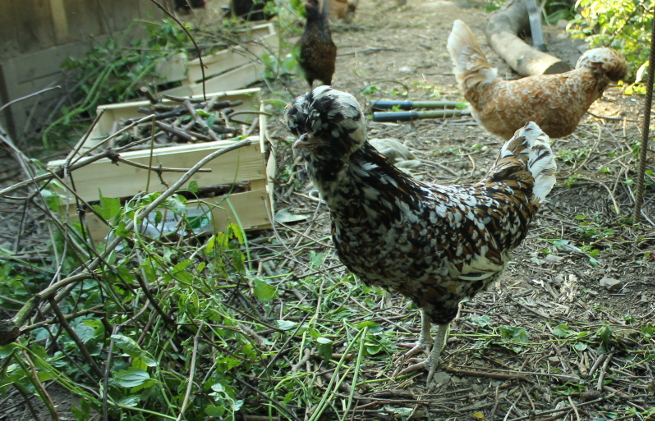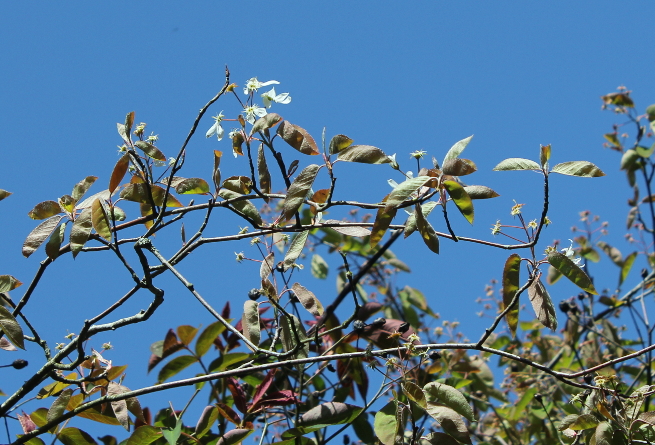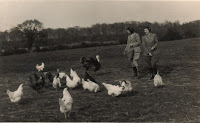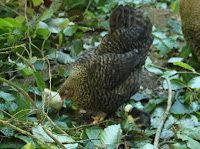In part one of this article we looked at the rich heritage of tree fodder and how it had been used as a form of arboricultural farming for many thousands of years. In this article I want to look at the practice in detail with reference to the choice of individual species, their nutritional value and their suitability as fodder and medicinals for both poultry and other livestock. If you haven't read part One you can find it here.
Below, one of my quail snacking on the first flush of hornbeam. I noticed that the quail preferred to eat the flower buds of the tree first. When I consulted the detailed nutritional breakdown of hornbeam from the European Data Base, this gave me some insights into why that might be but more of this below.
The 17th century English Agricultural author, John Worlidge encouraged the planting of trees to be pollarded in hedgerows:
‘For Ash, Elm, Poplar, Willow, and fuch Trees that are quick of growth, it is a very great profit that is made of them where Fewel is fcarce, by planting them in Hedge-rows, and other fpare places, and fhrouding them at five, fix, eight or ten years growth; they constantly bear a good head, and every time whilft the tree is in proof, the fhrouds increafe. They are out of the danger of the bite of Cattle, and require no fence’ (1669: 126).'
In France, many rural hedges still contain both ancient and newly planted pollards, now mostly for fuel rather than fodder, although this practice of using leaf fodder is now coming back with the growth of smallscale organic farming and permaculture. Pictured below in the background is a chateau driveway of ancient pollarded poplar, with a hedge of relatively new mixed deciduous pollards in the foreground field. Note the large tell-tale callouses or 'boilings' on the ancient poplars.
Tree Species Suitable for Pollarding or Pruning for Fresh Fodder or Tree Hay
I
have avoided my natural aversion to pollarding by simply just pruning my trees for
immediate consumption. That way I don't
have to be haunted by gnarled fingers but can still supply my poultry
with nutritious and readily-available forage. In a forest garden this
is an absolute boon as I have no grass available for immediate
consumption or of course, for hay. Any grass I have has to be brought in
from neighbours' meadows and with the present increase in homesteading
and food production, these 'set asides' are getting less and less
common. It is worth remembering, in their wild forms, poultry rarely
forage in open grass lands, they live in jungles and other wooded
areas. It is also worth noting that many present day grass-fed livestock
such as cattle, for example, started life as swamp and woodland
dwellers, which is probably why the Neolithic farmers carried on the
practice of silviculture and air meadows.
Throughout the centuries trees used and seen as excellent fodder crops in Europe were:
- alder, Alnus glutinosa
- ash, Fraxinus excelsior
- aspen Populus tremula
- beech, Fagus sylvatica
- elm, Ulmus minor
- hazel, Corylus avellana
- hornbeam, Carpinus betulus (pictured below pruned by the poultry!)
- poplar, Populus
- white hawthorn, Crataegus punctata (below left)
- willow, Salix
with
- sweet chestnut, Castanea sativa and oak, Quercus robur mixed in with other leaves
That said specific countries, such as Norway, for example include other favourites, which they still use to this day such as:
- goat willow, Salix caprea
- pine Pinus
- rowan, Sorbus aucuparia
Depending
on your climate and native (or well-established) species of trees there are so many options to choose
from when planning to grow these valuable forage crops. Researching
of your local farming history should lead you to the best varieties to
choose. I include below just a few examples from outside European and
similar climate zones (such as parts of the USA and Canada), however, it
would be really useful if you could share any experience or knowledge of
good choices for trees for poultry, in the comment section, as those species included below are
general livestock forages.
African
small livestock farmers for example, have for centuries fed forage on a
'wild browse' basis rather than specifically cultivated leaves for
such. The continent has nearly 10.000 species of trees of which 75% are
suitable for livestock feeding. Just a few examples of trees popular in
arboriculture for use in this respect being:
- gum arabic (Acacia senegal)
- whistling thorn (Acacia seyal)
- yeheb nut (Cordeauxia edulis)
A few examples popular in Central America
- hairy stamen leadtree (Leucaena trichandra)
- red calliandra (Calliandra calothyrsu)
- wild tamarind (Leucaena diversifolia)
The above are just a straw poll garnered from the net but I've included some links below to useful sites.
Poultry Specific Air Meadows?
My answer to this is; observation. With a forest garden we already have a good mix of trees both native and exotic to provide a smörgåsbord of leaves, flowers and fruit as potential fodder. We also have some prolific climbers, (more of the latter in a future post) and which are certainly part of the canopy and thus the air meadow. My philosophy has always been that poultry know more about what they should be eating than humans ever will. So I let them get on with it. By noting what is readily consumed at browse height, such as rose bush leaves, beech and hornbeam, I know their preferences. Just by watching what is and conversely what isn't, consumed when pruning, also informs me on my birds' choices in leaf fodder. For example wild clematis (above top) is prolific in leaf production and I was very gratified to find my hens eating them with gusto from the prunings.
Below: photograph of a quick walk around the garden looking for 'Nibble Test at Browse Height' evidence of what is and what isn't to the taste of our poultry.
Tree Fodder Zero Waste
After the birds have eaten the leaves, buds and any other bits they fancy the twigs are then left to dry and later used in our rocket stove from which we get hot coffee and food and on a cold day (or even a hot one) under which the chickens like to 'sunbathe'.
Nutritional Value
In
my previous article on the subject of leaf fodder, I actually went into
quite some detail as to the nutritional value of leaves such as
hornbeam and beech and you can find this linked in the related articles
below. Listed at the end of this article you can also find an
incredibly useful resource: European Data Base which you can use for the
trees existing on your
land or to give you an idea of those that would be useful fodder. Below
is a screen shot of just a small part of the data sampling at various
times of year for the first tree in my list - alder (Alnus glutinosa). This, to give you an idea of how useful this rich resource can be when planning your air meadow. You can also set certain parameters within the search to look at specific food values, which can inform your choice of tree or shrub.

There is also a link below to a Tropical Tree Forages List and the Forage Trees of Nepal which includes nutritional breakdowns and traditional uses. It is interesting to note also that in some countries there are still communal forests where livestock can be fed tree fodder and where branches can be cut for tree hay.
Tree Fodder as a Medicinal
Researching this subject you quickly realise that trees have a long and worldwide history of uses in medicine from heart treatments (hawthorn) and anti-inflammatory properties (Ash and Alder) to anti-bacterial (Beech) and painkilling properties (Willow). I've
already mentioned sheep self-medicating for parasites, and seemingly it
is the high tannin oak leaves that they choose. If you look at the uses of tree leaves in tisanes or herbal teas, again you will find a wide range of properties from poultices to the
treatment of respiratory conditions. As always I observe my poultry to see what they are consuming at any given time of year because often tree leaves provide vitamins and minerals that may be lacking or scarce in other forages. For example pine needles contain a high amount of vitamin C, which is one of the first vitamins to be lost when the body is under stress (such as is caused by extremes of temperature), I have seen my poultry pecking at the needles in Winter and at the new growth pine buds in early Spring.
Small Scale Air Meadows - Maximising your vertical growing space
The
other consideration in growing trees for your poultry is to remember
that many of them produce not just leaves which are edible but also
blossoms and fruit. However, the leaves of certain fruit trees, in particular stone fruit are
viewed with caution, as in some of the literature, I have read they are considered toxic. I've found varying
and contradictory reports on this however. I've even seen peach leaves mentioned as toxic and here in North Western France we make peach leaf wine. Conversely I've seen elderberry and mulberry mentioned as suitable forages but my birds will touch neither. So before you plant consider both searching for hands-on testimony and the 'Nibble test' and seek out some sample foliage.
One
example of an incredibly valuable 'multi-forage' tree in our garden is
Amelanchier or Serviceberry also known Saskatoon, an anglicisation of
the Cree; misâskwatômina, meaning 'the fruit of the tree of many
branches'. Mixed with tallow the dried berries, makes an incredible
Winter survival food and as such was highly prized by the First Nations.
It also has the advantage of being a very pretty tree both in blossom and in leaf, although you do not get the full idea from my image captured yesterday of the last few remaining petals.
My
birds, love its petals, they eat every single one that drops to the
earth and if it wasn't for the thorny Kiftsgate rose growing through it,
I'm sure they would be up the tree snacking on them up there. The
blackbirds however often beat both the chickens and ourselves to a major share of the berries. It's always a good gauge of the value of a plant when such fierce competition occurs.
The foliage is a fodder crop both for wild deer, rabbits and livestock.
Amelanchier
has not only nutritional benefits but it has been used in traditional
medicine for thousands of years. It is particularly prized for its
antioxidants, specifically phenolics, flavonols and anthocyanins, with
the latter at a higher level than most other berry fruits. This however is just one example, use the links provided to check for more possibilities!
Here's the film:
As already expressed my intention is to continue this theme with a look at harvesting tree hay for poultry (this will be in June), before then however, another article in this series will look at climbing plants for air meadows.
Thanks
for dropping by and do feel free to share experiences or ask for
further information in the comment section. If you have enjoyed this
piece and found it
useful think about sharing it with your family and friends, on social
media and also maybe about joining this blog
and/or subscribing to my Youtube channel or even supporting us on
Patreon or
It all helps to keep me going!
Until next time, all the very best from sunny Normandie!
Sue
© 2021 Sue Cross
REFERENCES
John Worlidge: A compleat system of husbandry and gardening; or, the
gentleman's companion, in the business and pleasures of a country life.
... The whole collected from, and containing what is most valuable in
all the books hitherto written upon this subject; ..
Pollarding Trees: Changing Attitudes to a Traditional Land Management Practice in Britain 1600–1900
Online fodder tree database for Europe - Nutritional Values
Tropical Forages List
Fodder trees for improving livestock productivity and smallholder livelihoods in Africa
James
Main: The Forest Planter and Pruner's Assistant: being a practical
treatise on the management of the native and exotic forest trees
commonly cultivated in Great Britain..
RELATED ARTICLES
Food For Free Fabulous Forage Part 8 Air Meadows for Poultry & Livestock
'Air meadows' is the beautiful description for a multi millennial old
tradition of feeding European livestock. The standard way of growing trees for...
read more
Food for Free. Fabulous Forage Part 1 Grass
For
centuries farmers and homesteaders raised poultry on a forage-based
diet supplemented only by a handful of grain and the occasional..
read more
Food for Free. Fabulous Forage Part 2 Chickweed
Stellaria media an incredible food and medicinal for poultry, an in-depth look at this ubiquitous weed..
read more
Food for Free. Fabulous Forage Part 3 Tree Fodder & Tree Hay
The idea of tree fodder is inextricably linked with the changing
landscape, the full domestication of animals, the concept of farming and
the clearance of the forests...
read more

Food for Free. Fabulous Forage Part 4 Roses for Food & Forest
For me the rose is the quintessential forest garden plant, from canopy to ground cover there are so many to choose from ...
read more
Food for Free. Fabulous Forage Part 5 Rose Petals
One of the main roses I use for both cooking, medicinals and which my
hens very much enjoy is, not surprisingly, rosa gallica Officinalis, or
The Apothecary Rose... read more
Food for Free Fabulous Forage Part 6 Rose Leaves and Hips
For thousands of years the rose, hips,
leaves and blossoms have been used as medicinals for both physical and
nervous system ailments. .....read more
Providing Forage for Organic Poultry Part 1
Going backwards to go forward - If you are setting up a forest garden to run your poultry
through it, you are probably going to be short of certain wild pasture elements...
read more
Providing Forage for Organic Poultry Part 2
Continuing an in-depth look into forage and discussing the what, when, where from and why...
read more

































